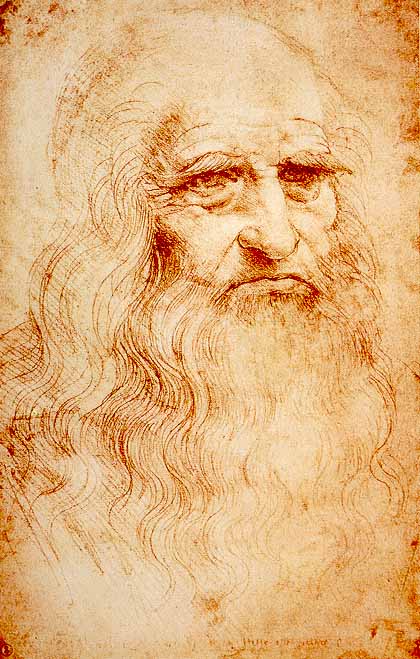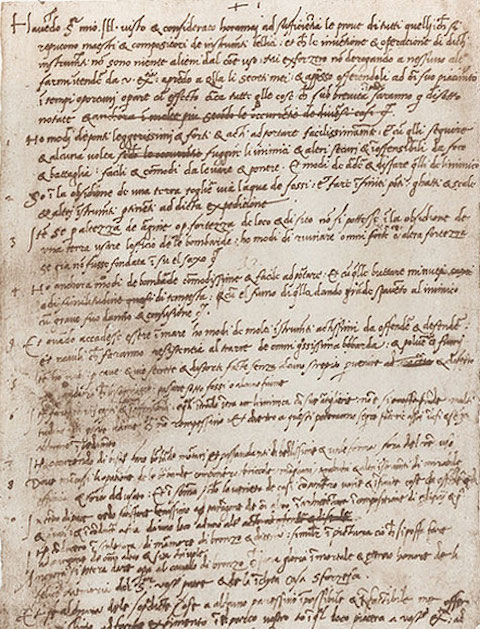Thinking Renaissance and Decentralization with Da Vinci

Rome’s main airport is named after Leonardo da Vinci, showing just how highly he is regarded as a pinnacle of genius among the many talents of the Renaissance. He is famous for his countless notes and ideas, but he has surprisingly few finished works. While this scarcity makes his surviving works even more valuable today, it’s no wonder that he didn’t have a good reputation with his clients. For instance, he was commissioned to paint the Mona Lisa but loved it so much that he never delivered it to the client. From a business perspective, he must have been quite terrible to work with. Moreover, his clients had to endure his experiments in their commissioned works. The atmospheric perspective in his masterpiece, the Mona Lisa, can be called a successful experiment. However, another masterpiece, The Last Supper, faded because he used unsuitable materials for a mural. It has since undergone massive restoration and is still being delicately maintained today. Even today, it’s not easy to be an artist without family support, and it was much more severe back then. For da Vinci, who had to rely entirely on the patronage of aristocrats and the wealthy, how could he possibly sustain his life of experimental art and ideas?
When he began his career in Florence, da Vinci was not the most celebrated talent of his time. He didn’t receive the same level of active patronage from the Medici family as Michelangelo and Raphael, who were active in a later period. He was also overshadowed by his contemporaries like Botticelli and Ghirlandaio (Michelangelo’s teacher), and thus was unable to secure direct patronage. Da Vinci’s pursuit of challenging and experimental art was not easily welcomed by the ruling elite, such as Lorenzo de’ Medici. Furthermore, this absolute dependence on a patron determined not only an artist’s support but also their downfall. The case of Jacques-Louis David, Napoleon’s chief painter, clearly shows how an artist’s fate can be tied to a single patron. When his patron, the absolute ruler Napoleon, fell from power, his career completely collapsed. Thus, betting one’s fate on a single patron could be a great risk for an artist. Da Vinci, who insisted on his own methods, was dissatisfied with his treatment in Florence and decided to go to Milan rather than compete with the artists there. The impressive point here is that he lived in a society where it was possible to move and find a new patron. If that possibility hadn’t existed, da Vinci might never have received the support needed for his anatomical studies and artistic experiments, and he could have faded away as just another name among many.

To move to Milan, da Vinci sent a letter to Duke Sforza, who ruled the city at the time. A copy of this letter, as seen in the attached photo, still exists in his notebooks, so we can see its contents. Surprisingly, the letter he sent to Duke Sforza doesn’t promote his abilities as an artist, but rather as a military engineer. The Sforza family had a background as mercenary captains who came to rule Milan, so they were very interested in military technology. Da Vinci tailored his application to the patron’s interests. Looking at this, it feels like the process wasn’t so different from applying for a job or a research grant today, despite the different era. Ultimately, da Vinci moved to Milan when the city requested an artist from Florence, but we don’t know for sure what role this letter played. While famous art history books later claimed the letter was simply ignored, we can also speculate that it must have played some part in the Sforza family’s decision to support him.
Da Vinci spent a long time in Milan as a court painter and engineer, but he later moved through Venice, papal Rome, and France, following historical events and new patrons. These movements are a great example of the decentralized environment of Northern Italy at the time, which made the Renaissance possible. While there were incredible financial patrons like the Medici family, the crucial point was not just the amount of patronage, but the fact that these patron families were spread across various cities. At that time, Northern Italy was a scene of competition not only among wealthy city-states built on Mediterranean trade but also including the Pope in Rome. Rulers in different regions wanted to display their superiority with better talent and superior art and architecture. Because of this, artists were not solely dependent on creating art for a single patron; they could, to some extent, seek out patrons amidst political and historical turmoil. Decentralization, and the competition within this decentralized environment, accelerated the development of science and art, and was the decisive driving force that gave birth to the Renaissance.

로마의 주요 공항 이름이 레오나르도 다빈치의 이름을 딸 만큼 다빈치는 르네상스의 여러 천재들 중에서도 현재 백미로 인정을 받는다. 레오나르도 다빈치는 수많은 노트와 아이디어로도 유명하지만 의외로 완성된 작품은 별로 없는 편이다. 이는 현재 남겨진 작품들은 더욱 높은 가치를 받도록 만들었지만, 이로 인해, 주문의뢰인들에게 좋은 평가를 듣지 못했음은 당연하다. 참고로 모나리자는 그가 의뢰를 받고 만들었지만 너무 마음에 들어서 주문자에게 보내지 않아 비즈니스 상대로 따지면 꽤나 끔찍했다고 봐야한다. 더욱이 의뢰인들은 다빈치의 실험을 작품에 감당해야 했다. 실험적 기법은 대단히 창의적이기도 하고 도전적이기도 하였는데 세기의 작품인 ‘모나리자’에 있는 공기 원근법이 성공적 실험이라고 할 수 있고 또 다른 작품인 ‘최후의 만찬’은 벽화에 부적절했던 재료로 인해 그림이 흐려져 대규모 복원 작업을 했고 현재도 민감하게 유지중이라고 한다. 현대에서도 예술은 소위 집안이 받쳐주지 않는다면 쉽지 않다고 하는데 그 당시는 훨씬 더 심했다. 현실적으로 귀족과 부유층의 후원에 순전히 기대야했던 다빈치에게 이런 실험적인 작품과 아이디어를 삶에서 어떻게 지속할 수 있었을까?
피렌체에서 본격적인 작품활동을 시작했던 다빈치는 당대에 가장 환영을 받는 재능은 아니었다. 다빈치 후대에 활동하는 미켈란젤로, 라파엘로처럼 메디치가의 적극적인 후원을 받지도 못했고 당대에도 보티첼리, 기를란다요(미켈란젤로의 스승)에 밀려 직접적인 후원을 받지도 못했다. 다빈치의 도전적이고 실험적인 예술의 추구는 권력층에서 환영받기 쉽지 않다. 예술가의 운명이 후원자 개인에게 얼마나 종속될 수 있는지는 나폴레옹의 수석화가였던 다비드의 사례가 극명하게 보여준다. 절대 권력자였던 후원자인 나폴레옹 몰락과 함께 그의 경력 또한 완전히 무너졌던 것이다. 이처럼 하나의 후원자에게 운명을 거는 것은 예술가에게 큰 위험이 될 수 있었다. 자신의 방식을 고수하던 다빈치는 피렌체에서의 대우에 만족하지 못했고 당대의 예술가들과 경쟁하기보다 밀라노로 가기로 결심한다. 여기서 인상적인 점은 후원자를 찾아 옮길 가능성이 있는 사회였다는 점이다. 만약 그런 가능성이 없었다면, 다빈치는 여기서 후원을 받지 못한채로 해부학이나 예술적 실험을 하지도 못하고 조용히 여러 이름들 중 하나로 남았을 수도 있다.

다빈치는 밀라노로 옮기기 위해 당시 밀라노를 다스리던 스포르차 공작에 편지를 보낸다. 이 편지는 첨부된 사진처럼 다빈치의 노트에 사본으로 아직도 남아있어 내용을 확인할 수 있다. 놀랍게도 다빈치가 스포르차 공작에게 보낸 편지에는 예술가로서의 다빈치가 아니라 군사기술자, 공학자로서의 다빈치의 능력이 어필되어 있다. 스포르차 가문은 용병대장출신으로 밀라노를 통치하게 된 배경이 있어 군사기술에 관심이 많기에 후원자의 관심사에 맞추어서 지원서를 낸 것이다. 이런 것을 보면 시대는 많이 다르지만 이 과정이 회사에 지원하거나 연구비 지원서를 쓰는 과정과 크게 다를 것이 없다고 느껴진다. 결국에 다빈치는 밀라노가 피렌체에 예술가의 파견을 요청할 때 밀라노로 옮겨가게 되는데, 이 편지가 어떻게 역할을 했는지 자세히 알 수는 없다. 이후 쓰여진 유명 미술사 책에서는 편지가 단순히 무시되었다고 하지만, 결국 스포르차 가문이 다빈치를 후원하기에 어떤 역할을 했을 것이라 추측을 해볼 수도 있다.
다빈치는 밀라노에서 꽤 오랜 시간을 궁정화가 겸 기술자로 지내지만, 이후 역사적인 상황과 후원자를 따라 베네치아, 교황의 로마, 프랑스로도 옮겨가며 인생을 살았다. 이러한 이동은 르네상스를 탄생시킬 수 있던 당시 북부 이탈리아의 탈중앙화된 환경을 잘 보여주는 예시라고 생각한다. 메디치 가문과 같은 엄청난 재정적 후원자들도 존재했지만, 후원의 액수 뿐만 아니라 이러한 후원자 가문이 여러 도시에 분산화되어 존재했다는 점이 결정적이었다. 당시 북부 이탈리아는 지중해 무역을 바탕으로한 부유한 여러 도시국가 뿐만 아니라 로마의 교황까지 경쟁을 하고 있던 상황이었다. 더 좋은 재능과 함께 더 좋은 예술과 건축을 통해 우월함을 보여주고 싶던 여러 지역의 통치차들이 존재했기에 재능있는 예술가들은 단순히 후원자를 위한 예술에만 목매지 않고 정치와 시대의 격변 속에서도 어느정도 후원자를 찾아나갈 수 있었다. 탈중앙화, 그리고 이 탈중앙화된 환경에서의 상호간의 경쟁이 학문과 예술의 발전을 가속화시켜 르네상스를 탄생시킨 결정적인 원동력이었다.
Enjoy Reading This Article?
Here are some more articles you might like to read next: